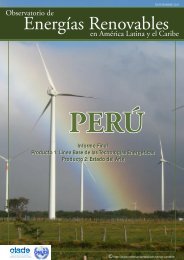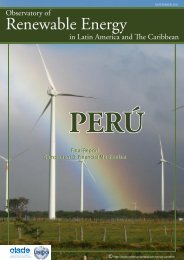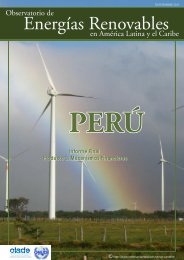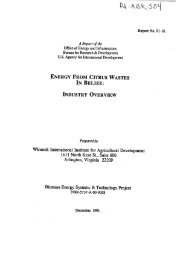PERÃ - Observatory for Renewable Energy in Latin America and
PERÃ - Observatory for Renewable Energy in Latin America and
PERÃ - Observatory for Renewable Energy in Latin America and
Create successful ePaper yourself
Turn your PDF publications into a flip-book with our unique Google optimized e-Paper software.
<br />
Perú- Products I <strong>and</strong> II<br />
<br />
renewable energy resources to AIPSAA to develop the electricity generation<br />
activity <strong>in</strong> the facilities of the thermal power station “Paramonga I”. Such<br />
concession was granted through the Def<strong>in</strong>ite Concession Contract of Generation<br />
with <strong>Renewable</strong> <strong>Energy</strong> Resources Nº 344 2009.<br />
2.4.5 Technological Aspects<br />
Technical <strong>and</strong> Interconnection Features<br />
“Agro Industrial Paramonga” generates electric <strong>and</strong> thermal power with a<br />
sugarcane byproduct: The bagasse. These wastes have a high calorific value, so<br />
when they are burned-out, they cause energy with smaller impact to the<br />
environment.<br />
The watertube boiler that runs on bagasse of sugar cane, produces 115 Ton/h of<br />
with a temperature of 400º C <strong>and</strong> 42,5 bar of pressure. This steam circulates <strong>for</strong> a<br />
pipe of Ø12” sch. 80, <strong>and</strong> is connected to a SIEMENS’s turb<strong>in</strong>e which is located<br />
<strong>in</strong> the housepower (MEM, 2011b).<br />
The turb<strong>in</strong>e delivers extraction steams <strong>in</strong> a temperature of 126º C <strong>and</strong> 2,39 bar of<br />
pressure, collected <strong>in</strong> a pipe of Ø36” sch.10, that is conducted to the ship of mills.<br />
The steam flow that was no extracted <strong>for</strong> the process of elaboration of sugar will<br />
cont<strong>in</strong>ue exp<strong>and</strong><strong>in</strong>g <strong>in</strong> the turb<strong>in</strong>e until a maximum vacuum pressure of 0,16 bar<br />
generat<strong>in</strong>g the additional electric power.<br />
Also count on a steam reduc<strong>in</strong>g station that works when <strong>in</strong> a determ<strong>in</strong>ed moment<br />
the turb<strong>in</strong>e stops deliver<strong>in</strong>g steam. In this station it is reduced the entrance<br />
pressure of 42,24 bar to 1,38 bar, <strong>and</strong> at the same time the steam is saturated to be<br />
able to deliver it to the system.<br />
The electric substation has 2 trans<strong>for</strong>mers. The first one is a three-phase<br />
trans<strong>for</strong>mer of 1 250 kVA of power <strong>and</strong> 13.8/0.480 kV <strong>and</strong> the second one is a<br />
three-phase trans<strong>for</strong>mer <strong>for</strong> light<strong>in</strong>g of 35 kVA 480/230 V.<br />
The <strong>in</strong>terconnection with the SEIN is executed <strong>in</strong> the bars of 13,8 kV of the<br />
“Paramonga” Substation of 138/13.8 kV property of the concessionary company<br />
“SN POWER” (CAHUA).<br />
Availability of the Resource<br />
The supply of energy <strong>and</strong> power is related to the stock of fuel <strong>for</strong> the<br />
Cogeneration Station, it means bagasse. Be<strong>for</strong>e the project’s execution, the plant<br />
of “AIPSAA” had a surplus of bagasse that justified its implementation.<br />
By 2009, the bagasse production amounted to 29 thous<strong>and</strong> Ton/month, with an<br />
average consumption <strong>in</strong> the boiler of 26 thous<strong>and</strong> Ton/month, generat<strong>in</strong>g a<br />
bagasse surplus of 3 thous<strong>and</strong> Ton/month (MEM, 2011b).<br />
128









